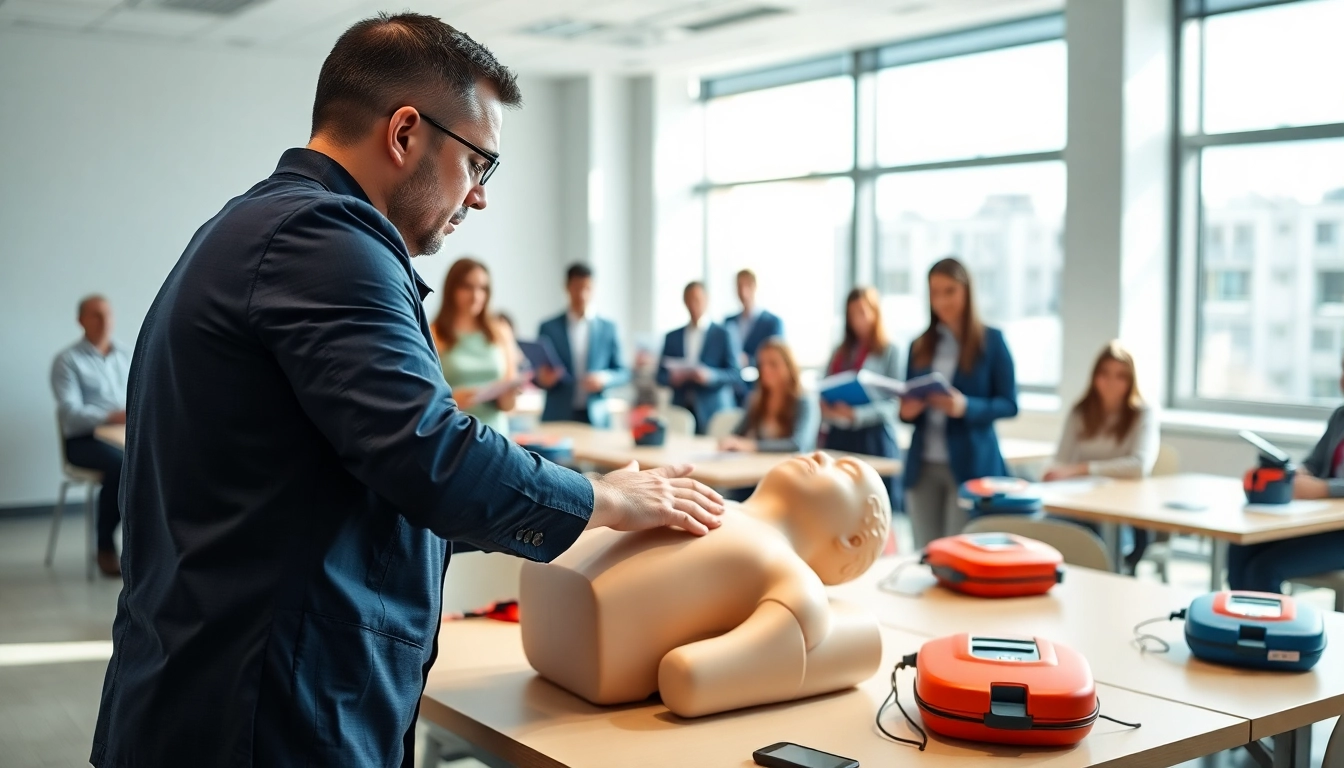Understanding AED Certification and Its Importance
What Is AED Certification?
AED certification refers to the formal recognition of individuals who have undergone training in the use of Automated External Defibrillators (AEDs) as well as basic life support emergency protocols. This training equips participants with the skills necessary to respond effectively during cardiac emergencies, often resulting from sudden cardiac arrest (SCA). AEDs are portable devices that analyze the heart’s rhythm and can deliver an electric shock if necessary to restore a normal heartbeat. Achieving aed certification ensures that recipients understand both the operation of the device and the responsibilities associated with providing lifesaving care in emergency situations.
Why Is AED Certification Essential?
AED certification is essential for numerous reasons, primarily concerning public safety. Cardiac arrests can occur unexpectedly, and immediate response can significantly improve survival rates. According to studies, the use of an AED within the first few minutes of a cardiac arrest can increase survival chances by as much as 70%. Certification indicates that an individual is prepared to act and can efficiently use an AED to provide assistance. Furthermore, possessing this certification is important in workplaces, schools, and sporting events, where bystanders may need to step in before emergency services arrive. In many regions, businesses and organizations are encouraged or required to have certified personnel on-site.
Common Myths About AED Certification
There are several misconceptions regarding AED certification that can deter individuals from seeking training. One prevalent myth is that AEDs are too complex for the average person to operate. In truth, these devices are designed to guide users through every step of the process with clear audio and visual prompts. Another misconception is that AED certification is only beneficial for healthcare professionals. While healthcare providers can greatly benefit from additional training, laymen and community members also gain necessary skills that can save lives. Lastly, many believe that only individuals in high-risk environments, such as hospitals or sports arenas, need to obtain certification; however, emergencies can occur anywhere, making it vital for everyone to be prepared.
Key Components of AED Certification Training
Basic Life Support Techniques
Basic life support (BLS) techniques form the foundation of AED certification training. These techniques include high-quality chest compressions and rescue breaths, which must be performed effectively to maintain circulation and oxygenation to vital organs during a cardiac arrest. Training typically covers the correct hand placement and compression depth required to maximize efficiency. Additionally, participants learn how to assess an emergency situation, perform a primary survey, and recognize the signs of a cardiac emergency.
Understanding AED Devices
Participants in AED certification courses are taught comprehensive information about AED devices. This includes familiarization with various types of AEDs, their functions, and their anatomical parts. Instruction emphasizes recognizing the device’s state (whether it is on or off), understanding battery life, and ensuring the device is ready for use at all times. Trainees learn how to properly attach the pads to patients and how to interpret the AED’s analysis for safe operation. Hands-on experience with different models enhances confidence and proficiency.
Safety Protocols During Emergencies
Safety is paramount during emergencies, and AED certification training emphasizes protocols to protect both the rescuer and the victim. Participants are instructed on the importance of assessing the safety of the environment before intervening. This includes ensuring that bystanders are safe and that the AED is in a suitable location. Furthermore, the training covers the necessity of knowing how to position oneself and the AED to minimize risks during defibrillation, including ensuring that no one is in contact with the patient when the shock is delivered.
Benefits of Obtaining AED Certification
Life-Saving Skills for Everyone
Perhaps the most significant benefit of obtaining AED certification is the acquisition of life-saving skills. Training provides individuals with the confidence they need to respond effectively to emergencies. Participants learn the critical components of BLS, device operation, and supportive measures, making them equipped to save lives outside of a clinical environment. As a proactive measure, individuals with certification can make a tangible difference in their communities, workplaces, or even while enjoying recreational activities.
Enhancing Workplace Safety
Workplaces are increasingly recognizing the importance of AED certification as part of occupational health and safety programs. Employers demonstrate their commitment to employee safety by ensuring that certified personnel are present at all times, particularly in larger organizations where the risk of emergencies can be higher. Through training, employees become more aware of potential health emergencies, which can lead to a more responsive culture. The presence of trained personnel not only protects employees but also enhances workplace morale and confidence.
Boosting Confidence in Emergencies
Certification instills a sense of confidence in those trained to use AEDs and perform BLS. Knowing that one is capable of stepping in during an emergency empowers individuals to act rather than freeze or hesitate. This confidence extends beyond emergency situations to personal experiences, as certified individuals often find themselves more prepared to handle health-related incidents across various settings. This mindset can create a ripple effect, encouraging others to engage in lifesaving training as well.
How to Prepare for AED Certification Courses
Choosing the Right Training Provider
When preparing for AED certification courses, it’s essential to select the right training provider. Research local organizations known for delivering quality instruction. Look for accredited training centers that adhere to established guidelines such as those set by the American Heart Association or the Red Cross. Reviews and testimonials can provide insight into the training quality, delivery style, and post-training support offered by providers. Additionally, consider factors such as course duration, cost, and certification validity.
Essential Materials and Resources
Before beginning the course, familiarize yourself with the materials and resources offered. Many providers supply manuals, instructional videos, and interactive tools designed to enhance your learning experience. Engaging with these resources in advance can significantly bolster your understanding and retention of critical concepts. Additionally, some courses may allow or recommend supplementary reading materials or online modules, which can enhance comprehension and boost confidence further.
Tips for Effective Learning
To maximize your learning experience during AED certification courses, consider implementing some effective study and practice strategies. Practice hands-on skills regularly, as muscle memory plays an essential role in responding efficiently during real-life emergencies. Participate actively in simulations and role-playing scenarios, as these can replicate the pressure of an actual situation. Take detailed notes during lectures, and engage in discussions to clarify any doubts with instructors. Maintaining an open mind and a willingness to learn will also lead to a more fulfilling educational journey.
After Completing Your AED Certification
Maintaining Your Certification
After achieving AED certification, it is vital to maintain your credentials routinely. Many certification programs require reconfirmation every two years, emphasizing continuing education and practice through refreshers or additional training courses. Staying updated on advancements in AED technology and modifications to CPR protocols is essential to ensure that your skills remain sharp and effective. Monitoring your certification’s expiration date and planning for renewal well in advance can help avoid gaps in competency.
Continuing Education Opportunities
Engaging in continuous learning is an integral part of maintaining an effective response capability. Many organizations offer continuing education programs that cover topics related to AED use, CPR, and general first aid. Participating in workshops, online courses, or community training events can broaden your knowledge base and introduce you to innovative approaches in emergency response. You may also consider joining local health and safety committees or groups where ongoing collaboration can enhance collective knowledge and skills.
Community Engagement and Advocacy
After becoming AED certified, individuals can significantly impact their communities by promoting awareness of cardiac emergencies and the importance of AED access and training. Engaging with local community organizations, schools, and businesses to advocate for AED placement and training programs fulfills an essential role in fostering safer environments. Hosting informational sessions or demonstrations can spread awareness and encourage more people to become certified, ultimately increasing the number of prepared bystanders during emergencies, thus enhancing community resilience overall.



